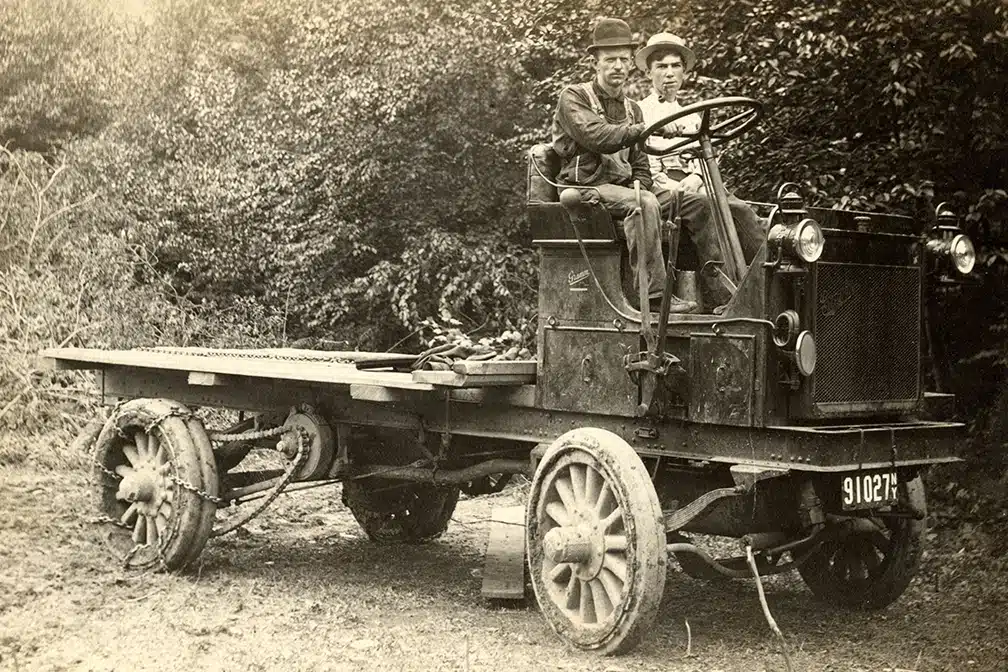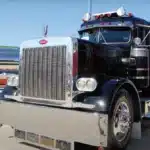Over the past year, XPO Trucking has seen an impressive surge in its market performance, with shares reaching near all-time highs and an increase of over 300%.
Continue Reading
April 27, 2024 10:43 am

Flatbed trucks are standard on American roads and construction sites, but their history is a captivating narrative of innovation, adaptation, and their profound influence on transportation and industry. These versatile vehicles have played an integral role in shaping various sectors of the American economy, tracing their roots from modest beginnings to contemporary significance.
The origins of flatbed trucks can be traced back to the early 20th century when automobile manufacturers experimented with various body styles for their vehicles. Before the emergence of flatbed trucks, cargo transportation relied heavily on horse-drawn wagons and cumbersome wooden carts. Creating a motorized vehicle with an open cargo area marked a monumental leap forward in transport.
One of the earliest trailblazers in the development of flatbed trucks was the White Motor Company, which introduced its groundbreaking Model 20 Stake Truck in 1917. This innovative vehicle featured a wooden platform at the rear, designed to transport various goods, from construction materials to agricultural products. This development marked a significant stride towards streamlining cargo transportation while reducing the reliance on manual labor.
As the demand for specialized hauling grew, flatbed truck designs diversified accordingly during the 1920s and 1930s. Manufacturers began producing custom flatbed trucks tailored to the unique needs of specific industries. These specialized vehicles boasted distinct configurations and accessories to cater to the diverse requirements of various businesses.
For instance, logging companies required flatbed trucks with robust frames and powerful engines to transport massive timber logs efficiently. Likewise, the construction industry demanded flatbed trucks equipped with built-in cranes or winches for lifting heavy equipment and materials onto the truck’s bed. These adaptations underscored the adaptability of flatbed trucks in serving many purposes.
Flatbed trucks were pivotal in supporting the war effort during World War II. They were employed to transport troops, equipment, and supplies across multiple theaters of operation. The wartime necessity accelerated advancements in truck technology, resulting in the development of sturdier and more versatile flatbed trucks.
Post-war, the construction boom and the expansion of the interstate highway system further bolstered the demand for flatbed trucks. Manufacturers such as Ford, Chevrolet, and Dodge continued refining their designs and producing trucks with enhanced payload and towing capabilities. This era marked the transition from the rudimentary stake-bed trucks of the past to the contemporary flatbed trucks we recognize today.
Flatbed trucks underwent significant technological advancements in the latter half of the 20th century and into the 21st century.
Flatbeds became rare in the 1980s as most road freight changed to either containers or pallet loads carried on more extensive and efficient trucks, optimized for quicker loading by fork-lift trucks.
However, introducing hydraulic lifts, cranes, and winches made loading and unloading cargo more efficient and safer. Materials used in construction also evolved, with steel, aluminum, and composite materials replacing traditional wood, making flatbeds more durable and lightweight.
Moreover, flatbed trucks became integral to transporting oversized loads, including heavy machinery, construction equipment, and industrial components. The emergence of specialized trailers, such as lowboy and drop-deck trailers, further expanded their capabilities, allowing for transporting huge and heavy cargo.
One of the remarkable characteristics of flatbed trucks is their versatility. Over the years, they have proven themselves adaptable to various industries and applications. Let’s delve deeper into how these trucks have become the go-to choice for multiple sectors.
Construction Industry: Flatbed trucks have played an indispensable role in the construction industry. Their open cargo area provides ample space for transporting construction materials such as lumber, steel beams, concrete blocks, and scaffolding. Additionally, the availability of hydraulic cranes and winches on modern flatbed trucks has made it easier to load and unload heavy construction equipment like bulldozers, excavators, and backhoes. This efficiency has accelerated construction projects and enhanced job site safety.
Agriculture and Farming: Flatbed trucks have been the backbone of agriculture and farming in rural America. These trucks transport hay bales, livestock, and farming equipment. Farmers rely on flatbed trucks to carry produce to markets and distribute supplies across their expansive properties. The adaptability of flatbeds means they can accommodate different configurations to suit the specific needs of the agricultural sector.
Transporting Oversized Cargo: Flatbed trucks are renowned for their ability to transport oversized and irregularly shaped cargo. They are frequently used for hauling wind turbine components, prefabricated houses, and other large items that wouldn’t fit within the confines of a standard enclosed truck. Specialized flatbed trailers, such as extendable and RGN (Removable Gooseneck) trailers, have been developed to meet these demands. These trailers can handle even the most challenging loads, making flatbed trucks indispensable for transporting oversized items.
Commercial and Residential Moving: Moving companies often rely on flatbed trucks for their relocation services. The open cargo space allows for efficient loading and unloading of furniture and household goods. Additionally, flatbed trucks are used for towing other vehicles or transporting boats and recreational vehicles.
Military and Defense: The military has long recognized the utility of flatbed trucks. These vehicles are used for troop transport, military equipment, and mobile command centers. Their adaptability and robust design make them ideal for deployment in diverse environments, from rugged terrains to urban settings.
Environmental Impact
As the world becomes increasingly conscious of the environmental impact of transportation, flatbed trucks have been included in the pursuit of sustainability. Manufacturers are exploring ways to reduce emissions and improve fuel efficiency in flatbed truck designs. Alternative fuels, such as natural gas and electricity, are becoming more common in the industry. Additionally, aerodynamic enhancements are being incorporated into truck designs to minimize wind resistance and reduce fuel consumption during highway travel.
The Future of Flatbed Trucks
Looking ahead, the future of flatbed trucks in America seems promising. Continued advancements in technology, including autonomous driving systems and telematics, are likely to enhance the safety and efficiency of these vehicles. Additionally, as environmental concerns continue to grow, we expect to see more eco-friendly innovations in flatbed truck design.
The history of flatbed trucks in America is a testament to their enduring importance in transportation and industry. Flatbed trucks have evolved significantly from their early beginnings as open cargo platforms to their current role as versatile workhorses serving many sectors. Their adaptability, resilience, and ability to handle oversized and irregularly shaped cargo have made them indispensable to the American economy. As the transportation landscape continues to evolve, flatbed trucks will remain at the forefront, playing a pivotal role in shaping the future of logistics and industry in the United States.
Over the past year, XPO Trucking has seen an impressive surge in its market performance, with shares reaching near all-time highs and an increase of over 300%.
Continue ReadingOngoing Mack Trucks Labor Dispute's Impact on Truck Drivers & the Trucking Industry – The Background of the Dispute, and Details of the Disagreements.
Continue ReadingAs we approach 2024, the trucking industry stands at a crossroads of change and adaptation. With insights from Truckstop, let’s explore the most crucial developments that truck
Continue ReadingIntroduced late 2023, the Guaranteeing Overtime for Truckers Act (GOT Act) has sparked discussion in the trucking industry. Find out
Continue ReadingUAW Workers are ready to strike at Daimler Truck North America in Charlotte, NC. They threaten to walk out in
Continue ReadingThe EPA has introduced the Clean Heavy-Duty Vehicles Program granting $1 billion to transition standard heavy-duty vehicles to their zero-emission
Continue ReadingThe ATRI recently published a report that shows renewable diesel is a much better way to reduce carbon emissions than
Continue ReadingThe Autonomous Vehicle Industry Association (AVIA) released its first-ever "State of AV" report, suggesting a lack of coherent policies hinders
Continue ReadingOOIDA • ATA • DOT • NASTC • WOMEN IN TRUCKING • NPTC • DRIVER RESOURCES • TDN STAFF • ARCHIVES • SITEMAP

